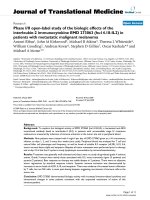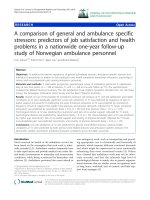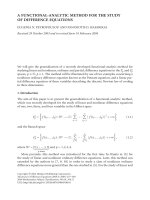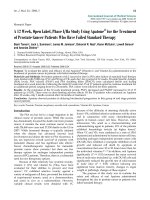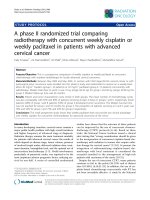A phase II open label, randomised study of ipilimumab with temozolomide versus temozolomide alone after surgery and chemoradiotherapy in patients with recently diagnosed glioblastoma: The
Bạn đang xem bản rút gọn của tài liệu. Xem và tải ngay bản đầy đủ của tài liệu tại đây (506.1 KB, 5 trang )
Brown et al. BMC Cancer
(2020) 20:198
/>
STUDY PROTOCOL
Open Access
A phase II open label, randomised study of
ipilimumab with temozolomide versus
temozolomide alone after surgery and
chemoradiotherapy in patients with
recently diagnosed glioblastoma: the IpiGlio trial protocol
Nicholas F. Brown1, Stasya M. Ng2, Claire Brooks2, Tim Coutts2, Jane Holmes3, Corran Roberts3, Leena Elhussein3,
Peter Hoskin4, Tim Maughan5, Sarah Blagden6 and Paul Mulholland1,4,7*
Abstract
Background: Median survival for patients with glioblastoma is less than a year. Standard treatment consists of
surgical debulking if feasible followed by temozolomide chemo-radiotherapy. The immune checkpoint inhibitor
ipilimumab targets cytotoxic T-lymphocyte-associated protein 4 (CTLA-4) and has shown clinical efficacy in
preclinical models of glioblastoma. The aim of this study is to explore the addition of ipilimumab to standard
therapy in patients with glioblastoma.
Methods/design: Ipi-Glio is a phase II, open label, randomised study of ipilimumab with temozolomide (Arm A)
versus temozolomide alone (Arm B) after surgery and chemoradiotherapy in patients with recently diagnosed
glioblastoma. Planned accrual is 120 patients (Arm A: 80, Arm B: 40). Endpoints include overall survival, 18-month
survival, 5-year survival, and adverse events. The trial is currently recruiting in seven centres in the United Kingdom.
Trial registration: ISRCTN84434175. Registered 12 November 2018.
Keywords: Glioblastoma, Glioma, Ipilimumab, Temozolomide
Background
Glioblastoma is the most common malignant primary
brain tumour [1]. Survival is poor, with a median survival from diagnosis of 14.6–21.1 months with standard
therapy in clinical trials [2–7]. However, registry databases report overall survival of only 6–10 months [8, 9].
Standard therapy is surgical debulking if feasible, with
the degree of resection correlating with prognosis [10–
13]. This is followed by adjuvant chemoradiotherapy
* Correspondence:
1
Department of Oncology, University College London Hospitals, 250 Euston
Road, London NW1 2PQ, UK
4
Mount Vernon Cancer Centre, Rickmansworth Road, Northwood HA6 2RN,
UK
Full list of author information is available at the end of the article
given within 6 weeks of surgery, with 60 Gray (Gy) of
fractionated focal external beam radiotherapy administered in 30 fractions over 6 weeks, along with daily concomitant temozolomide 75 mg/m2. Following a 28-day
break, patients receive six cycles of adjuvant temozolomide 150-200 mg/m2, given for 5 days in a 28-day cycle.
This standard was implemented following demonstration
of a 2.5 month median survival benefit over radiotherapy
alone in the landmark EORTC-NCIC randomised phase
III trial [6, 14]. There is no standard therapy for patients
at relapse who are typically treated with lomustine given
as monotherapy or in combination with procarbazine
and vincristine (PCV) [15, 16].
The traditional dogma of the CNS as an immuneprivileged site has been widely eroded, and there is now
© The Author(s). 2020 Open Access This article is distributed under the terms of the Creative Commons Attribution 4.0
International License ( which permits unrestricted use, distribution, and
reproduction in any medium, provided you give appropriate credit to the original author(s) and the source, provide a link to
the Creative Commons license, and indicate if changes were made. The Creative Commons Public Domain Dedication waiver
( applies to the data made available in this article, unless otherwise stated.
Brown et al. BMC Cancer
(2020) 20:198
convincing evidence that the CNS has a fully functioning, although tightly regulated, innate and adaptive immune system, underpinned by a functional lymphatic
system [17]. Malignant gliomas elicit systemic immune
dysregulation, with reduced CD4+ T-cell number and
function, and increased Tregs [18–21].
The amplitude and quality of T-cell responses are regulated by a balance of co-inhibitory and co-stimulatory
signals, termed immune checkpoints. These “checkpoints” allow a rapid and effective response against foreign antigens, whilst preventing overstimulation and
auto-immune responses. T-cell activation after antigen
recognition by the T-cell receptor is a complex integration of these stimulatory and inhibitory signals. Gliomas
exploit these checkpoints, with expression of negative
regulators of immune response and conversion of cytotoxic T-cells to regulatory T-cells in the tumour microenvironment to escape immune surveillance [17, 22].
Cytotoxic T-lymphocyte antigen-4 (CTLA-4, CD152)
is a CD28 homolog with a 100–1000 higher affinity for
B7 (CD80/86). However, unlike CD28, CTLA-4 does not
produce a costimulatory signal when bound to B7. The
degree of CD28:B7 binding versus CTLA-4:B7 binding
determines whether a T cell is activated or undergoes
anergy [23]. In resting naïve T cells CTLA-4 is regulated
in part by its subcellular localisation: it is principally
found in intracellular vesicles and not functional until
expressed on the cell surface [24]. CTLA-4 is constitutively expressed on Tregs and plays a key role in generating tolerance [25]. Thus CTLA-4 is a principal
regulator of an effective immune response [26–28].
Ipilimumab is a human IgG monoclonal antibody
specific for CTLA-4 and blocks the interaction with B7,
augmenting T cell activation and proliferation. In preclinical glioblastoma models, systemic CTLA-4 blockade produces an effective T-cell response, tumour
shrinkage, and prolongs survival [29–32]. Efficacy in
patients with melanoma with brain metastases provide
clinical evidence of activity within the central nervous
system [33–35].
The aim of this phase II trial is to evaluate the addition
of ipilimumab to standard therapy in patients with recently diagnosed glioblastoma. This manuscript describes protocol version 3.0 (13 August 2019).
Methods
Study objectives
The primary objective of this study is to evaluate
whether the addition of ipilimumab to the current standard of care following surgery and radiotherapy will
improve survival in patients with newly diagnosed glioblastoma. Secondary objectives are evaluation of the
safety and tolerability of ipilimumab with temozolomide
versus temozolomide alone, and whether the addition of
Page 2 of 5
ipilimumab to the standard of care improves long term
survival. Accordingly, the study endpoints are overall
survival, overall survival at 18 months, overall survival at
5 years, and any toxicity grade 3 of higher according to
the Common Terminology Criteria for Adverse Events
(CTCAE) v4.03 [36].
Trial design
This study is an open label, stratified randomised, multicentre, phase II clinical trial. Following informed consent, patients will enter a screening phase during which
the eligibility for randomisation will be determined. Patients who meet the eligibility criteria will be randomly
allocated in a 2:1 ratio to receive either ipilimumab with
temozolomide (Arm A) or temozolomide alone (Arm B).
A total of 120 patients will be randomised, with 80 patients in Arm A and 40 patients in Arm B. Treatment allocation will be by minimisation incorporating a random
element, and will be carried out by computer. Randomisation will be stratified by extent of surgery (total versus
subtotal resection) and MGMT promotor methylation
(methylated, unmethylated, or unknown). Randomised
patients will enter the treatment phase. After stopping
study treatment, patients will remain on study for surveillance for 52 weeks following the date of randomisation. Tumour progression will be assessed by contrast
enhanced MRI performed every 12 weeks as per standard care until tumour progression. Survival status will be
collected at 18 months from the date the last patient is
randomised, and at 2, 3 and 5 years from each patient’s
randomisation date.
Patient cohort
Patients are currently being recruited from 7 sites in the
United Kingdom (Addenbrooke’s Hospital, Cambridge;
Churchill Hospital, Oxford; Guy’s Hospital, London;
Mount Vernon Cancer Centre, Middlesex; The Christie,
Manchester; University College Hospital, London; Western General Hospital, Edinburgh). The first patient enrolled in January 2019.
Inclusion criteria include: newly diagnosed histologically confirmed de-novo supratentorial glioblastoma
with greater than 20% surgical debulking; radiotherapy
to have begun within 49 days of surgery; completed
standard radiotherapy with concurrent oral temozolomide; age 18–70 years of age; life expectancy of at least
12 weeks; ECOG performance status 0 or 1; haemoglobin ≥9 g/dL; platelet count ≥100 × 109/L; absolute neutrophil count (ANC) ≥ 1 × 109/L; lymphocyte count
≥0.5 × 109/L; serum creatinine < 1.5 upper limit of normal (ULN) or Cockroft-Gault creatinine clearance ≥50
mL/min; bilirubin ≤1.5x ULN (or ≤ 3x if known Gilbert’s
syndrome); ALT or AST ≤ 3x ULN.
Brown et al. BMC Cancer
(2020) 20:198
Exclusion criteria include: multifocal glioblastoma; secondary glioblastoma; known extracranial or leptomeningeal disease; any other treatment for glioblastoma other
than surgery and temozolomide chemoradiotherapy;
dexamethasone dose > 3 mg daily (or equivalent); significant intra- or peri-tumoral haemorrhage; clinically relevant, active, known or suspected autoimmune disease;
history of significant gastrointestinal impairment; history
of interstitial lung disease; any condition requiring systemic steroid therapy (> 10 mg prednisolone daily or
equivalent); other active malignancy; known history of
Hepatitis B or C or HIV; and pregnant or breast-feeding
women.
Page 3 of 5
thrombocytopenia or associated with bleeding, AST or
ALT > 5–10 x ULN for > 14 days, AST or ALT > 10 x
ULN, total bilirubin > 5 x ULN, concurrent AST or ALT
> 3 x ULN and total bilirubin > 2 x ULN); any grade 4
AE except skin AEs only where not considered to be
related to ipilimumab, neutropenia, lymphopenia or
leukopenia, isolated lipase/amylase elevations without
clinical manifestations of pancreatitis and endocrinopathies which resolve or are adequately controlled with
physiological hormone replacement (as discussed with
trial management group); or dosing delays > 42 days
from the previous dose (unless approved by the trial
management group).
Study treatment
Study treatments include ipilimumab (Yervoy™) (Arm A)
and temozolomide (TMZ) (Arms A and B).
Ipilimumab
Ipilimumab will be dosed at 3 mg/kg and administered
as an intravenous infusion over 90 min. The first cycle of
ipilimumab will be administered within 14 days of completing radiotherapy and within 3 days of randomisation.
Ipilimumab will be administered once every 3 weeks for
a total of 4 infusions. No dose reduction is permitted.
Dosing will be delayed in the following occurrences:
grade ≥ 2 adverse events (AEs) (except grade 2 skin AEs,
fatigue, or laboratory abnormalities other than ALT/
AST); grade 3 skin AEs; grade 3 laboratory AEs (except
grade ≥ 3 lymphopaenia or grade ≥ 3 amylase/lipase if no
clinical evidence of pancreatitis). Ipilimumab retreatment may resume once the AE returns to grade ≤ 1 or
baseline. Patients may resume treatment with grade 2 fatigue, or drug-related endocrinopathies once adequately
controlled with physiological hormone replacement if
discussed and approved by the trial management group.
Ipilimumab related pulmonary AEs, diarrhoea or colitis
must return to baseline prior to resuming treatments except grade ≥ 3 diarrhoea/colitis where ipilimumab must
be permanently discontinued. Persistent grade 1 pneumonitis may resume treatment after a steroid taper over
at least 1 month.
Ipilimumab will be permanently discontinued if any of
the following suspected ipilimumab related AEs occur:
grade ≥ 2 uveitis, eye pain, or blurred vision that does
not respond to topical therapy and does not improve to
grade 1 severity within the retreatment period, or that
requires systemic treatment; grade ≥ 3 uveitis, pneumonitis, bronchospasm, hypersensitivity reaction, or infusion
reaction; grade ≥ 3 drug-related AEs, with the following
exceptions: grade 3 skin AEs, endocrinopathies adequately controlled with only physiological hormonal replacement, and laboratory abnormalities (other than the
following which do require discontinuation: grade 3
Temozolomide
Temozolomide will be administered orally for 6 cycles in
both Arms A & B. Temozolomide will commence as per
standard care following completion of chemoradiotherapy. Dosing is once daily for 5 days in a 28-day cycle.
The dose in cycle 1 is 150 mg/m2 (dose level 0), unless
ANC < 1.5 × 109/L, platelet count < 100 × 109/L, or any
non-haematological toxicity ≥ grade 2 (except alopecia,
nausea, vomiting) during concomitant temozolomide administration with radiotherapy, in which case temozolomide will be initiated at 100 mg/m2 (dose level − 1). If no
non-haematological toxicity ≥ grade 2 (except alopecia,
nausea, or vomiting) is experienced in cycle 1, ANC is
≥1.5 × 109/L, and platelet count ≥100 × 109/L the dose is
escalated to 200 mg/m2 (dose level 1) from cycle 2 (or to
150 mg/m2 if cycle 1 was dosed at 100 mg/m2). If the
dose was not escalated at Cycle 2, escalation is not done
in subsequent cycles. The temozolomide dose will be reduced if ANC < 1.0 × 109/L or platelet count < 75 × 109/
L or for grade 3 non-haematological toxicity (except alopecia, nausea, vomiting). If AEs persist, treatment will be
delayed by 1 week for up to 4 consecutive weeks, after
which if AEs have not resolved to ≤ grade 1 then temozolomide will be discontinued. Temozolomide will be
stopped if the same grade 3 non-haematological toxicity
(except alopecia, nausea, vomiting) recurs after dose reduction, or if treatment at dose level − 1 results in unacceptable toxicity.
Statistical considerations
To give a power of 80% to show a significant difference
of 22.5 month median survival in Arm A (ipilimumab +
temozolomide) and 15 month median survival in Arm B
(temozolomide alone) at one sided 20%, allowing for 5%
loss to follow-up at 3 years, 120 patients need to be recruited (80 to Arm A, 40 to Arm B). This assumes an
18-month recruitment period and survival follow-up for
a minimum of 18 months.
Brown et al. BMC Cancer
(2020) 20:198
Page 4 of 5
Discussion
The objective of this study is to evaluate whether the
addition of ipilimumab to temozolomide following
standard chemoradiotherapy improves survival in patient
with glioblastoma. Given the recent failures of phase 3
trials of new therapies in glioblastoma to demonstrate
survival benefit following apparent efficacy in single arm
phase II trials [37], Ipi-Glio includes a standard of care
arm (Arm B), with a 2:1 randomisation between Arm A
and B in order to aid recruitment.
A limitation of this study is a lack of biomarkers to
provide potential determinants of clinical response to
ipilimumab. There is no accepted biomarker for response to ipilimumab therapy. Studies in melanoma
have found a number of markers that are associated with
response to ipilimumab, including expression of genes
associated with antigen presentation [38], the T-cell receptor repertoire [39], HLA-I heterozygosity [40],
tumour mutational burden [39], somatic copy number
mutation burden [41]; systemic immune response factors
such as serum IL-6 levels [42]; and gut microbiome variants [43]. These factors will need to be considered in future studies. Further, antibiotic use in the month prior
to administration of the PD-1 checkpoint inhibitor
nivolumab is associated with poorer survival [44]. This is
of particular importance for glioblastoma, as cotrimoxazole is routinely administered with temozolomide chemoradiotherapy as prophylaxis against P.jiroveci
pneumonia. In Ipi-Glio, patients are enrolled after completing radiotherapy, but in future trials withdrawal of
routine co-trimoxazole should be considered. The IpiGlio study is currently ongoing.
Appeal and Bristol-Myers Squibb had no role in the design of the study or
collection, analysis, and interpretation of data, or in the writing of this manuscript. The manuscript was reviewed by the funding bodies prior to
publication.
Abbreviations
AE: Adverse event; ANC: Absolute neutrophil count; CNS: Central nervous
system; CTCAE: Common Terminology Criteria for Adverse Events; CTLA4: Cytotoxic T-lymphocyte-associated protein 4; Gy: Gray; PCV: Procarbazine,
lomustine, vincristine; RT: Radiotherapy; TMZ: Temozolomide; ULN: Upper
limit of normal
Received: 19 November 2019 Accepted: 11 February 2020
Acknowledgements
We are thankful to staff at participating hospitals, patients, and their families
and carers for their contributions to the study. The study sites receive
infrastructure support from National Institute for Health Research (NIHR)
Biomedical Research Centre (BRC) initiatives. The trial is sponsored by the
University of Oxford and managed by the Oncology Clinical Trials Office
(OCTO). Independent oversight of the trial is provided by the Radiotherapy
and Imaging Trial Oversight Committee (RIOC).
Authors’ contributions
PM and NB designed the study, wrote the initial trial protocol, and drafted
the manuscript. CB and SN are the trial managers. TC is the trial
administrator involved in data collection. JH, CR and LE are the trial
statisticians. TM is the Director of the University of Oxford Oncology Clinical
Trials Office; PH is the chair of the independent oversight committee. SB
assisted with trial initiation. All authors read and approved the final
manuscript.
Funding
Ipi-Glio is funded by the National Brain Appeal and Bristol-Myers Squibb with
further funding support from the CRUK Oxford Centre. The National Brain
Availability of data and materials
Not applicable.
Ethics approval and consent to participate
This study will be conducted in accordance with the Declaration of Helsinki,
the principles of Good Clinical Practice, and applicable clinical trials
regulations. Study conduct is approved by the South Central (Oxford B)
Research Ethics Committee (18/SC/0525) and the Medicines and Healthcare
Regulatory Agency. All patients will provide written informed consent prior
to participation in the trial. The clinical sites are Addenbrooke’s Hospital
(Cambridge University Hospitals NHS Foundation Trust), The Christie (The
Christie NHS Foundation Trust), Churchill Hospital (Oxford University
Hospitals NHS Foundation Trust), Guy’s Hospital (Guy’s and St Thomas’ NHS
Foundation Trust), Mount Vernon Cancer Centre (The Hillingdon Hospitals
NHS Foundation Trust), University College Hospital (University College
London Hospitals NHS Foundation Trust), and Western General Hospital (NHS
Lothian).
Consent for publication
Not applicable.
Competing interests
The authors declare that they have no competing interests.
Author details
1
Department of Oncology, University College London Hospitals, 250 Euston
Road, London NW1 2PQ, UK. 2Oncology Clinical Trials Office (OCTO),
Department of Oncology, The University of Oxford, Old Road Campus
Research Building, Oxford OX3 7DQ, UK. 3Centre for Statistics in Medicine
(CSM), University of Oxford, Botnar Research Centre, Windmill Road, Oxford
OX3 7LD, UK. 4Mount Vernon Cancer Centre, Rickmansworth Road,
Northwood HA6 2RN, UK. 5Oxford Institute for Radiation Oncology, University
of Oxford, Old Road Campus Research Building, Roosevelt Drive, Oxford OX3
7DQ, UK. 6Department of Oncology, University of Oxford, Old Road Campus
Research Building, Oxford OX3 7DQ, UK. 7UCL Cancer Institute, 72 Huntley St,
London WC1E 6AG, UK.
References
1. Louis DN, Perry A, Reifenberger G, von Deimling A, Figarella-Branger D,
Cavenee WK, Ohgaki H, Wiestler OD, Kleihues P, Ellison DW. The 2016 World
Health Organization classification of tumors of the central nervous system: a
summary. Acta Neuropathol. 2016;131(6):803–20.
2. Chinot OL, Wick W, Mason W, Henriksson R, Saran F, Nishikawa R, Carpentier
AF, Hoang-Xuan K, Kavan P, Cernea D, et al. Bevacizumab plus radiotherapytemozolomide for newly diagnosed glioblastoma. N Engl J Med. 2014;
370(8):709–22.
3. Gilbert MR, Dignam JJ, Armstrong TS, Wefel JS, Blumenthal DT, Vogelbaum
MA, Colman H, Chakravarti A, Pugh S, Won M, et al. A randomized trial of
bevacizumab for newly diagnosed glioblastoma. N Engl J Med. 2014;370(8):
699–708.
4. Johnson DR, O'Neill BP. Glioblastoma survival in the United States before
and during the temozolomide era. J Neurooncol. 2012;107(2):359–64.
5. Malkki H. Trial watch: Glioblastoma vaccine therapy disappointment in
phase III trial. Nat Rev Neurol. 2016;12(4):190.
6. Stupp R, Hegi ME, Mason WP, van den Bent MJ, Taphoorn MJ, Janzer RC,
Ludwin SK, Allgeier A, Fisher B, Belanger K, et al. Effects of radiotherapy with
concomitant and adjuvant temozolomide versus radiotherapy alone on
survival in glioblastoma in a randomised phase III study: 5-year analysis of
the EORTC-NCIC trial. Lancet Oncol. 2009;10(5):459–66.
7. Stupp R, Taillibert S, Kanner AA, et al. Maintenance therapy with tumortreating fields plus temozolomide vs temozolomide alone for glioblastoma:
a randomized clinical trial. JAMA. 2015;314(23):2535–43.
Brown et al. BMC Cancer
8.
9.
10.
11.
12.
13.
14.
15.
16.
17.
18.
19.
20.
21.
22.
23.
24.
25.
26.
27.
28.
29.
30.
(2020) 20:198
Brodbelt A, Greenberg D, Winters T, Williams M, Vernon S, Collins VP.
National Cancer Information Network Brain Tumour G: Glioblastoma in
England: 2007-2011. Eur J Cancer. 2015;51(4):533–42.
Ostrom QT, Gittleman H, Fulop J, Liu M, Blanda R, Kromer C, Wolinsky Y,
Kruchko C, Barnholtz-Sloan JS. CBTRUS Statistical Report: Primary brain and
central nervous system tumors diagnosed in the United States in 2008–
2012. Neuro-oncology. 2015;17(Suppl 4):iv1–iv62.
Brown TJ, Brennan MC, Li M, Church EW, Brandmeir NJ, Rakszawski KL, Patel
AS, Rizk EB, Suki D, Sawaya R, et al. Association of the Extent of resection
with survival in Glioblastoma: a systematic review and meta-analysis. JAMA
Oncol. 2016;2(11):1460–9.
Almenawer SA, Badhiwala JH, Alhazzani W, Greenspoon J, Farrokhyar F,
Yarascavitch B, Algird A, Kachur E, Cenic A, Sharieff W, et al. Biopsy versus
partial versus gross total resection in older patients with high-grade glioma:
a systematic review and meta-analysis. Neuro-oncology. 2015;17(6):868–81.
Hess KR. Extent of resection as a prognostic variable in the treatment of
gliomas. J Neurooncol. 1999;42(3):227–31.
Sanai N, Berger MS. Glioma extent of resection and its impact on patient
outcome. Neurosurgery. 2008;62(4):753–64 discussion 264-756.
Stupp R, Mason WP, van den Bent MJ, Weller M, Fisher B, Taphoorn MJ,
Belanger K, Brandes AA, Marosi C, Bogdahn U, et al. Radiotherapy plus
concomitant and adjuvant temozolomide for glioblastoma. N Engl J Med.
2005;352(10):987–96.
Weller M, van den Bent M, Tonn JC, Stupp R, Preusser M, Cohen-JonathanMoyal E, Henriksson R, Rhun EL, Balana C, Chinot O, et al. European
Association for Neuro-Oncology (EANO) guideline on the diagnosis and
treatment of adult astrocytic and oligodendroglial gliomas. Lancet Oncol.
2017;18(6):e315–29.
Stupp R, Brada M, van den Bent MJ, Tonn JC, Pentheroudakis G, Group
EGW. High-grade glioma: ESMO Clinical Practice Guidelines for diagnosis,
treatment and follow-up. Ann Oncol. 2014;25(Suppl 3):iii93–101.
Brown NF, Carter TJ, Ottaviani D, Mulholland P. Harnessing the immune
system in glioblastoma. Br J Cancer. 2018;119(10):1171–81.
Fecci PE, Mitchell DA, Whitesides JF, Xie W, Friedman AH, Archer GE,
Herndon JE, Bigner DD, Dranoff G, Sampson JH. Increased regulatory T-cell
fraction amidst a diminished CD4 compartment explains cellular immune
defects in patients with malignant Glioma. Cancer Res. 2006;66(6):3294.
Morford LA, Elliott LH, Carlson SL, Brooks WH, Roszman TL. T cell receptormediated signaling is defective in T cells obtained from patients with
primary intracranial tumors. J Immunol. 1997;159(9):4415.
Choi BD, Fecci PE, Sampson JH. Regulatory T cells move in when Gliomas
say “I DO”. Clin Cancer Res. 2012;18(22):6086–8.
Roszman TL, Brooks WH. Immunobiology of primary intracranial tumours. III.
Demonstration of a qualitative lymphocyte abnormality in patients with
primary brain tumours. Clin Exp Immunol. 1980;39(2):395–402.
Ooi YC, Tran P, Ung N, Thill K, Trang A, Fong BM, Nagasawa DT, Lim M,
Yang I. The role of regulatory T-cells in glioma immunology. Clin Neurol
Neurosurg. 2014;119(0):125–32.
Krummel MF, Allison JP. CD28 and CTLA-4 have opposing effects on the
response of T cells to stimulation. J Exp Med. 1995;182(2):459–65.
Linsley PS, Bradshaw J, Greene J, Peach R, Bennett KL, Mittler RS. Intracellular
trafficking of CTLA-4 and focal localization towards sites of TCR
engagement. Immunity. 1996;4(6):535–43.
Takahashi T, Tagami T, Yamazaki S, Uede T, Shimizu J, Sakaguchi N, Mak TW,
Sakaguchi S. Immunologic self-tolerance maintained by CD25(+)CD4(+)
regulatory T cells constitutively expressing cytotoxic T lymphocyteassociated antigen 4. J Exp Med. 2000;192(2):303–10.
Leach DR, Krummel MF, Allison JP. Enhancement of antitumor immunity by
CTLA-4 blockade. Science (New York, NY). 1996;271(5256):1734–6.
Postow MA, Callahan MK, Wolchok JD. Immune checkpoint blockade in
Cancer therapy. J Clin Oncol. 2015;33(17):1974–82.
Brunet JF, Denizot F, Luciani MF, Roux-Dosseto M, Suzan M, Mattei MG,
Golstein P. A new member of the immunoglobulin superfamily--CTLA-4.
Nature. 1987;328(6127):267–70.
Fecci PE, Ochiai H, Mitchell DA, Grossi PM, Sweeney AE, Archer GE,
Cummings T, Allison JP, Bigner DD, Sampson JH. Systemic CTLA-4 blockade
ameliorates glioma-induced changes to the CD4+ T cell compartment
without affecting regulatory T-cell function. Clin Cancer Res. 2007;13(7):
2158–67.
Reardon DA, Gokhale PC, Klein SR, Ligon KL, Rodig SJ, Ramkissoon SH, Jones
KL, Conway AS, Liao X, Zhou J, et al. Glioblastoma eradication following
Page 5 of 5
31.
32.
33.
34.
35.
36.
37.
38.
39.
40.
41.
42.
43.
44.
immune checkpoint blockade in an Orthotopic, Immunocompetent model.
Cancer Immunol Res. 2016;4(2):124–35.
Wainwright DA, Chang AL, Dey M, Balyasnikova IV, Kim CK, Tobias A, Cheng
Y, Kim JW, Qiao J, Zhang L, et al. Durable therapeutic efficacy utilizing
combinatorial blockade against IDO, CTLA-4, and PD-L1 in mice with brain
tumors. Clin Cancer Res. 2014;20(20):5290–301.
Genoud V, Marinari E, Nikolaev SI, Castle JC, Bukur V, Dietrich PY, Okada H,
Walker PR. Responsiveness to anti-PD-1 and anti-CTLA-4 immune
checkpoint blockade in SB28 and GL261 mouse glioma models.
Oncoimmunology. 2018;7(12):e1501137.
Margolin K, Ernstoff MS, Hamid O, Lawrence D, McDermott D, Puzanov I,
Wolchok JD, Clark JI, Sznol M, Logan TF, et al. Ipilimumab in patients with
melanoma and brain metastases: an open-label, phase 2 trial. Lancet Oncol.
2012;13(5):459–65.
Konstantinou MP, Dutriaux C, Gaudy-Marqueste C, Mortier L, Bedane C,
Girard C, Thellier S, Jouary T, Grob JJ, Richard MA, et al. Ipilimumab in
melanoma patients with brain metastasis: a retro-spective multicentre
evaluation of thirty-eight patients. Acta Derm Venereol. 2014;94(1):45–9.
Queirolo P, Spagnolo F, Ascierto PA, Simeone E, Marchetti P, Scoppola A,
Del Vecchio M, Di Guardo L, Maio M, Di Giacomo AM, et al. Efficacy and
safety of ipilimumab in patients with advanced melanoma and brain
metastases. J Neurooncol. 2014;118(1):109–16.
Common Terminology Criteria for Adverse Events Version 4.03 [https://evs.
nci.nih.gov/ftp1/CTCAE/CTCAE_4.03/CTCAE_4.03_2010-06-14_
QuickReference_5x7.pdf]. Accessed 12 Nov 2019.
Mandel JJ, Yust-Katz S, Patel AJ, Cachia D, Liu D, Park M, Yuan Y, Kent TA, de
Groot JF. Inability of positive phase II clinical trials of investigational
treatments to subsequently predict positive phase III clinical trials in
glioblastoma. Neuro-Oncology. 2018;20(1):113–22.
Shukla SA, Bachireddy P, Schilling B, Galonska C, Zhan Q, Bango C, Langer R,
Lee PC, Gusenleitner D, Keskin DB, et al. Cancer-Germline Antigen
Expression Discriminates Clinical Outcome to CTLA-4 Blockade. Cell. 2018;
173(3):624–33 e628.
Havel JJ, Chowell D, Chan TA. The evolving landscape of biomarkers for
checkpoint inhibitor immunotherapy. Nat Rev Cancer. 2019;19(3):133–50.
Chowell D, Morris LGT, Grigg CM, Weber JK, Samstein RM, Makarov V, Kuo F,
Kendall SM, Requena D, Riaz N, et al. Patient HLA class I genotype
influences cancer response to checkpoint blockade immunotherapy.
Science. 2018;359(6375):582–7.
Davoli T, Uno H, Wooten EC, Elledge SJ. Tumor aneuploidy correlates with
markers of immune evasion and with reduced response to immunotherapy.
Science. 2017;355(6322):eaaf8399.
Valpione S, Pasquali S, Campana LG, Piccin L, Mocellin S, Pigozzo J, ChiarionSileni V. Sex and interleukin-6 are prognostic factors for autoimmune toxicity
following treatment with anti-CTLA4 blockade. J Transl Med. 2018;16(1):94.
Chaput N, Lepage P, Coutzac C, Soularue E, Le Roux K, Monot C, Boselli L,
Routier E, Cassard L, Collins M, et al. Baseline gut microbiota predicts clinical
response and colitis in metastatic melanoma patients treated with
ipilimumab. Ann Oncol. 2019.
Pinato DJ, Howlett S, Ottaviani D, et al. Association of Prior Antibiotic
Treatment With Survival and Response to Immune Checkpoint Inhibitor
Therapy in Patients With Cancer [published online ahead of print, 2019 Sep
12]. JAMA Oncol. 2019;e192785. />
Publisher’s Note
Springer Nature remains neutral with regard to jurisdictional claims in
published maps and institutional affiliations.

